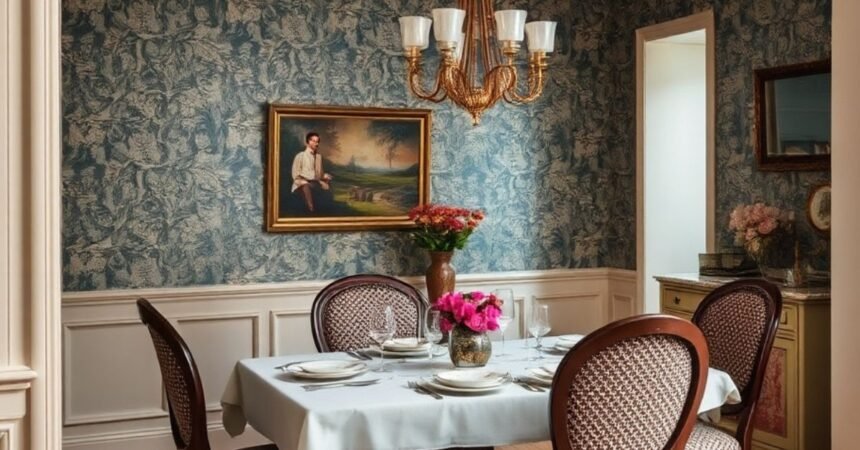Dining rooms, once the center of family gatherings and social interaction, are slowly disappearing from modern homes. As the way people live, work, and entertain evolves, dedicated dining spaces are being replaced by multifunctional areas. This shift in home design reflects changing lifestyles, where formal dining is less common, and flexibility is prioritized. In this article, we explore the reasons behind the disappearance of dining rooms, how it affects home life, and what this trend says about the future of living spaces.
The History of the Dining Room: A Symbol of Tradition
Historically, the dining room has been a symbol of formality and tradition. It served as the heart of the home, a place where families gathered to share meals and conversation. In the 19th and early 20th centuries, dining rooms were often grand spaces. Reserved for special occasions or daily family dinners. Large dining tables, ornate chairs, and fine china were common fixtures. Reflecting the importance of the room in social and family life.
However, the concept of the dining room began to change as lifestyles became more fast-paced. The post-war era saw a shift toward more casual dining experiences, with the rise of kitchen nooks and open-plan living. The dining room, once a dedicated space for formal meals, started to lose its prominence. As more people embraced informal dining, the need for a separate room diminished.
By the late 20th century, dining rooms had already begun their decline in many homes. Families were eating out more often, and the rise of TV dinners further eroded the tradition of gathering around the dining table. Today, the disappearance of dining rooms is a continuation of this trend. Homes are designed with a focus on flexibility and multifunctionality.
Why Dining Rooms Are Disappearing: Shifting Lifestyles and Priorities
One of the main reasons dining rooms are disappearing is the shift in how people live and use their homes. Modern lifestyles demand more flexible and adaptable spaces, which often means sacrificing traditional, single-purpose rooms like the dining room. Open-concept living, where the kitchen, living room, and dining area are combined into one large space, has become increasingly popular. This layout allows for more fluid interaction between family members and guests, making the home feel more connected and spacious.
In many homes, the kitchen has become the new center of social life. Families now gather around kitchen islands or breakfast bars, where meals are prepared and eaten in a more casual setting. This shift toward casual dining reflects a broader cultural trend of informality, where the rigid structure of formal meals has given way to a more relaxed approach to eating.
Another factor contributing to the disappearance of dining rooms is the growing demand for multifunctional spaces. Homeowners are increasingly looking for ways to maximize every square foot of their homes, especially in urban areas where space is limited. Dining rooms, which are often used only occasionally, are being repurposed into more practical spaces like home offices, playrooms, or additional living areas. The desire for flexibility in home design has led many to question the necessity of a dedicated dining room.
Additionally, the rise of remote work and the increasing need for home offices have further pushed dining rooms out of the spotlight. In homes where space is at a premium, converting the dining room into a functional office or study area makes more sense than keeping it as an underused dining space. This shift highlights the changing priorities of modern homeowners, who value practicality and versatility over formality.
The Impact of Disappearing Dining Rooms on Family Life
As dining rooms disappear, the way families interact and share meals is also changing. For many, the traditional family dinner has become less frequent, replaced by more casual meals eaten in the kitchen or living room. This shift away from formal dining has both positive and negative effects on family life.
On the positive side, the disappearance of dining rooms can lead to more relaxed and flexible family interactions. In an open-concept living space, family members are more likely to spend time together, even while engaged in different activities. For example, parents can cook dinner while children complete homework at the kitchen island, allowing for more opportunities for conversation and connection.
However, the loss of a dedicated dining space can also mean fewer opportunities for focused, intentional family time. The tradition of sitting down for a meal together, free from distractions, has long been a cornerstone of family bonding.
The disappearance of dining rooms also reflects broader changes in how people view and prioritize family meals. In today’s busy world, many families struggle to find the time to sit down for a traditional dinner. Between work, school, and extracurricular activities, schedules often don’t align, making it challenging to gather everyone at the table. As a result, family meals are often eaten on the go or in front of the television, further eroding the practice of formal dining.
Despite these changes, it’s important to note that the disappearance of dining rooms doesn’t mean the end of family meals. Many families are finding new ways to connect over food, whether it’s through casual meals in the kitchen or outdoor dining in the backyard. The shift away from formal dining is simply a reflection of changing lifestyles and priorities, rather than a loss of family connection altogether.
The Rise of the Multifunctional Space: Redefining Home Design
As dining rooms disappear, homes are being designed with a greater emphasis on multifunctional spaces. Open-concept layouts, which combine the kitchen, living room, and dining area into one cohesive space, have become the norm in modern home design. This trend reflects the desire for flexibility and adaptability, allowing homeowners to make the most of their available space.
Multifunctional spaces offer several advantages over traditional, single-purpose rooms. For one, they allow for more efficient use of space, especially in smaller homes or apartments. Instead of dedicating an entire room to dining. Homeowners can create a versatile area that serves multiple purposes, from eating and entertaining to working and relaxing.
In addition, multifunctional spaces promote a more connected and social atmosphere in the home. By eliminating walls and barriers between rooms, open-concept layouts encourage interaction and conversation between family members and guests. This sense of openness and fluidity is particularly appealing in today’s fast-paced, interconnected world.
Another benefit of multifunctional spaces is their ability to adapt to changing needs over time. As families grow and lifestyles change, these spaces can be easily reconfigured to accommodate new purposes. For example, a dining area might be transformed into a home office. A playroom, or a hobby space, depending on the family’s needs.
Despite these advantages, some homeowners still prefer the traditional separation of rooms, valuing the formality and structure that a dining room provides. For these individuals, the dining room represents a space for special occasions and gatherings. Offering a sense of ritual and tradition that can’t be replicated in a multifunctional space.
The Future of Dining Spaces: Blending Tradition with Modernity
While dining rooms are disappearing in many modern homes, they are not gone entirely. In fact, some homeowners are finding creative ways to blend tradition with modernity, creating flexible dining spaces that serve multiple purposes. For example, dining rooms are being designed with built-in storage or fold-away furniture, allowing the space to be easily transformed when not in use.
Others are incorporating dining areas into larger, multifunctional spaces, such as open-concept kitchens or living rooms. In these designs, the dining area remains a focal point for family meals and gatherings but is integrated into a more casual, flexible layout. This approach allows homeowners to maintain the tradition of formal dining while also embracing the practicality of modern living.
In the future, dining spaces will likely continue to evolve, reflecting the changing needs and priorities of homeowners. As homes become more multifunctional and adaptable. Dining rooms may take on new forms or disappear entirely in favor of more flexible spaces. However, the act of gathering around a table to share a meal will always remain an important part of family life, regardless of how dining spaces are designed.
Conclusion: The Disappearing Dining Room Reflects a Changing Lifestyle
The disappearance of dining rooms is a reflection of broader changes in how people live, work, and entertain. As modern lifestyles prioritize flexibility, functionality, and efficiency, traditional dining rooms are being replaced by multifunctional spaces that better suit today’s needs. While the loss of a dedicated dining room may seem like a departure from tradition, it’s simply an evolution in home design that reflects the changing priorities of modern homeowners.
Despite the shift away from formal dining, the importance of gathering for meals remains. Whether in a traditional dining room, a casual kitchen nook, or an outdoor patio, the act of sharing food. Conversation will always be a central part of home life. The disappearance of the dining room is not the end of family meals, but rather a new chapter in how we design and use our living spaces.







